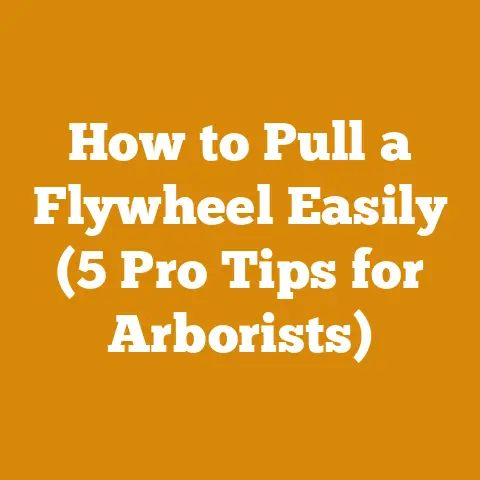How to Clean Staircase Oak Treads (Pro Woodcare Tips)
I remember the first time I truly appreciated the beauty of wood, not just as a material for building or burning, but as a living, breathing part of our homes. It was during a visit to my grandfather’s old farmhouse. The staircase, crafted from solid oak, was worn smooth by decades of footsteps, each tread telling a silent story. The rich patina glowed warmly in the afternoon sun, a testament to the enduring quality of the wood and the care it had received (or, in some cases, lacked) over the years.
That staircase sparked a lifelong fascination with wood and its preservation. Now, I want to share what I’ve learned about cleaning and maintaining oak staircase treads, so you can preserve their beauty for generations to come. This isn’t just about cleaning; it’s about woodcare, plain and simple.
How to Clean Staircase Oak Treads (Pro Woodcare Tips)
Globally, the wood flooring market, which includes stair treads, is a multi-billion dollar industry, projected to reach over $60 billion in the next few years. This growth underscores the enduring popularity of wood as a building material and the importance of proper maintenance to protect this investment. In North America, oak remains one of the most popular choices for staircases due to its durability, beauty, and availability. However, like any natural material, oak requires regular cleaning and care to prevent damage and maintain its appearance.
Why Oak Stair Treads Need Special Care
Oak, a hardwood prized for its strength and grain patterns, isn’t invincible. It’s susceptible to scratches, dents, water damage, and fading from sunlight. Understanding these vulnerabilities is the first step in providing proper care.
- Wear and Tear: High-traffic areas like staircases are prone to wear and tear from foot traffic, especially from shoes that track in dirt and grit.
- Moisture Damage: Oak is porous and can absorb moisture, leading to warping, staining, and even rot if not properly sealed and maintained.
- Finish Degradation: The finish on oak treads, whether it’s varnish, polyurethane, or oil, can wear down over time, leaving the wood vulnerable to damage.
- UV Exposure: Sunlight can fade and discolor oak, particularly if it’s not protected with a UV-resistant finish.
Key Concepts in Woodcare
Before diving into the cleaning process, let’s define some key concepts:
- Finish: The protective coating applied to the wood surface. Common finishes include polyurethane, varnish, lacquer, shellac, and oil-based finishes. Understanding the type of finish on your stairs is crucial for selecting the right cleaning products.
- pH Neutral Cleaner: A cleaner that has a pH level of 7, which is neither acidic nor alkaline. This is important for preventing damage to the wood finish.
- Microfiber Cloth: A type of cloth made from synthetic fibers that are highly absorbent and gentle on surfaces. Ideal for dusting and cleaning wood.
- Wood Conditioner: A product that helps to moisturize and protect wood, preventing it from drying out and cracking.
- Paste Wax: A protective coating that adds shine and helps to repel water and dirt.
Step-by-Step Guide to Cleaning Oak Stair Treads
Here’s a detailed, step-by-step guide to cleaning your oak staircase treads, incorporating professional woodcare techniques:
Step 1: Gather Your Supplies
Before you begin, gather the necessary supplies. This will save you time and prevent interruptions during the cleaning process.
- Soft Broom or Vacuum with Brush Attachment: For removing loose dirt and debris.
- pH-Neutral Wood Floor Cleaner: Avoid harsh chemicals or abrasive cleaners, as they can damage the finish. Bona and Method are well-regarded brands.
- Two Buckets: One for clean water and one for the cleaning solution.
- Microfiber Mop or Cloths: These are gentle on wood and won’t leave streaks.
- Wood Conditioner (Optional): For nourishing and protecting the wood.
- Paste Wax (Optional): For adding shine and extra protection.
- Soft-Bristled Scrub Brush (Optional): For tackling stubborn dirt or stains.
- Safety Glasses: To protect your eyes from splashes.
- Gloves: To protect your hands from chemicals.
Step 2: Prepare the Area
Clear the staircase of any obstacles, such as rugs, shoes, or decorations. This will give you unobstructed access to the treads and prevent accidents. Open windows or turn on a fan to ventilate the area.
Step 3: Remove Loose Dirt and Debris
Use a soft broom or vacuum with a brush attachment to remove loose dirt, dust, and debris from the treads. Pay close attention to the corners and edges, where dirt tends to accumulate.
Step 4: Prepare the Cleaning Solution
Fill one bucket with clean, lukewarm water and add the pH-neutral wood floor cleaner according to the manufacturer’s instructions. Avoid using too much cleaner, as this can leave a residue on the treads.
Step 5: Damp-Mop the Treads
Dip a microfiber mop or cloth into the cleaning solution, wring it out thoroughly, and gently mop the treads. Work in small sections, overlapping each stroke to ensure even coverage. Avoid soaking the wood, as this can cause damage.
Step 6: Rinse with Clean Water
Fill the second bucket with clean, lukewarm water. Dip a clean microfiber mop or cloth into the water, wring it out thoroughly, and gently wipe the treads to remove any remaining cleaning solution.
Step 7: Dry the Treads
Use a clean, dry microfiber cloth to thoroughly dry the treads. Pay close attention to the corners and edges, where moisture tends to linger. You can also use a fan to speed up the drying process.
Step 8: Apply Wood Conditioner (Optional)
Once the treads are completely dry, you can apply a wood conditioner to nourish and protect the wood. Follow the manufacturer’s instructions for application. Typically, you’ll apply a thin, even coat of conditioner with a clean cloth and allow it to soak into the wood for the recommended time.
Step 9: Apply Paste Wax (Optional)
If you want to add shine and extra protection to your oak treads, you can apply a paste wax. Follow the manufacturer’s instructions for application. Typically, you’ll apply a thin, even coat of wax with a clean cloth, allow it to dry for the recommended time, and then buff it to a shine with a clean cloth or buffing machine.
Step 10: Allow to Dry Completely
Allow the treads to dry completely before walking on them. This may take several hours, depending on the humidity and temperature.
Dealing with Stubborn Stains and Scratches
Sometimes, regular cleaning isn’t enough to remove stubborn stains or scratches. Here are some tips for dealing with these issues:
- Water Stains: For water stains, try using a mixture of equal parts white vinegar and water. Apply the mixture to the stain with a clean cloth, let it sit for a few minutes, and then wipe it away with a clean, dry cloth.
- Grease Stains: For grease stains, try using a paste of baking soda and water. Apply the paste to the stain, let it dry completely, and then wipe it away with a clean cloth.
- Scratches: For minor scratches, you can try using a wood touch-up marker or crayon that matches the color of the wood. For deeper scratches, you may need to sand the area and apply a new coat of finish.
- Gum: Applying ice in a plastic bag can help to freeze the gum, making it easier to remove without damaging the wood.
Important Note: Always test any cleaning solution or stain removal method in an inconspicuous area first to ensure that it doesn’t damage the finish.
Preventative Measures for Long-Term Care
Prevention is always better than cure. Here are some preventative measures you can take to protect your oak staircase treads:
- Use Rugs or Mats: Place rugs or mats at the top and bottom of the staircase to trap dirt and debris.
- Remove Shoes: Encourage family members and guests to remove their shoes before walking on the staircase.
- Trim Pet’s Nails: Keep your pet’s nails trimmed to prevent them from scratching the wood.
- Clean Spills Immediately: Wipe up spills as soon as they occur to prevent staining.
- Use Furniture Pads: Place furniture pads under the legs of any furniture that sits on the staircase to prevent scratches.
- Control Humidity: Maintain a consistent humidity level in your home to prevent the wood from drying out or warping.
- UV Protection: Consider UV-resistant window film or curtains to protect the oak from sun damage.
- Regular Cleaning: Establish a regular cleaning schedule to prevent dirt and grime from building up.
Choosing the Right Cleaning Products
Selecting the right cleaning products is crucial for maintaining the beauty and integrity of your oak staircase treads. Here’s a breakdown of what to look for:
- pH-Neutral Cleaners: As mentioned earlier, pH-neutral cleaners are essential for preventing damage to the wood finish. Look for cleaners specifically designed for wood floors or wood furniture.
- Avoid Harsh Chemicals: Avoid cleaners that contain ammonia, bleach, or other harsh chemicals, as these can strip the finish and damage the wood.
- Read Labels Carefully: Always read the labels carefully and follow the manufacturer’s instructions.
- Consider Natural Cleaners: For a more eco-friendly option, consider using natural cleaners like vinegar and water or baking soda and water. However, always test these cleaners in an inconspicuous area first to ensure that they don’t damage the finish.
- Check Ingredients: Be aware of ingredients like citrus oils in some cleaners, as they can sometimes damage certain finishes over time.
Understanding Different Types of Wood Finishes
Knowing the type of finish on your oak treads is critical for choosing the right cleaning and maintenance products. Here’s a brief overview of common wood finishes:
- Polyurethane: A durable, water-resistant finish that’s easy to clean and maintain. It’s a popular choice for high-traffic areas like staircases.
- Varnish: Similar to polyurethane, but often more flexible and less prone to cracking.
- Lacquer: A fast-drying finish that provides a smooth, glossy surface. It’s less durable than polyurethane or varnish and requires more frequent maintenance.
- Shellac: A natural finish that provides a warm, amber glow. It’s not as water-resistant as polyurethane or varnish and is more susceptible to damage.
- Oil-Based Finishes: Finishes that penetrate the wood and provide a natural look and feel. They require regular maintenance with oil-based products.
To determine the type of finish on your oak treads, you can try a simple test. Apply a small amount of denatured alcohol to an inconspicuous area. If the finish dissolves or becomes sticky, it’s likely shellac or lacquer. If it doesn’t dissolve, it’s likely polyurethane or varnish. Oil finishes will usually absorb the alcohol readily.
Costs and Budgeting
Cleaning and maintaining oak staircase treads doesn’t have to break the bank. Here’s a breakdown of potential costs:
- Cleaning Supplies: A pH-neutral wood floor cleaner typically costs between $10 and $20 per bottle. Microfiber mops and cloths cost between $5 and $15 each.
- Wood Conditioner: Wood conditioner typically costs between $15 and $30 per bottle.
- Paste Wax: Paste wax typically costs between $10 and $20 per can.
- Professional Cleaning: If you prefer to hire a professional cleaning service, expect to pay between $100 and $300, depending on the size of the staircase and the extent of the cleaning required.
- Refinishing: If the finish on your oak treads is severely damaged, you may need to refinish them. This can cost between $500 and $2000, depending on the size of the staircase and the type of finish.
To save money, you can purchase cleaning supplies in bulk, use natural cleaners, and perform regular maintenance to prevent the need for more expensive repairs.
Case Study: Restoring a Neglected Oak Staircase
I once worked with a client who had a beautiful oak staircase that had been neglected for years. The treads were covered in dirt, grime, and scratches, and the finish was peeling in several places.
We started by thoroughly cleaning the treads with a pH-neutral wood floor cleaner and a soft-bristled scrub brush. We then used a wood touch-up marker to fill in minor scratches. For deeper scratches, we sanded the affected areas and applied a new coat of polyurethane finish.
Finally, we applied a coat of paste wax to add shine and protection. The result was a stunning transformation. The staircase looked like new, and the client was thrilled with the results.
This case study highlights the importance of regular cleaning and maintenance, as well as the potential for restoring even severely damaged oak staircase treads.
Common Pitfalls to Avoid
- Using Abrasive Cleaners: Abrasive cleaners can scratch and damage the wood finish.
- Soaking the Wood: Soaking the wood can cause it to warp or rot.
- Using Too Much Cleaner: Using too much cleaner can leave a residue on the treads.
- Ignoring Spills: Ignoring spills can lead to staining and water damage.
- Neglecting Regular Maintenance: Neglecting regular maintenance can lead to more expensive repairs down the road.
- Using the Wrong Finish: Applying the wrong finish can damage the wood or create an uneven appearance. Always consult with a professional if you’re unsure about which finish to use.
- Skipping Sanding: If refinishing, not sanding sufficiently can lead to poor adhesion of the new finish.
- Applying Finish in Humid Conditions: High humidity can affect the drying time and quality of the finish.
Troubleshooting Guide
- Streaks after cleaning: Ensure you are wringing out the mop or cloth thoroughly enough. Excess water can leave streaks. Consider using a different cleaning product or rinsing with clean water more thoroughly.
- Dull finish: The finish may be worn down. Consider applying a new coat of wax or refinishing if necessary.
- Sticky residue: You may be using too much cleaner or the wrong type of cleaner. Try rinsing with clean water and drying thoroughly.
- Stains that won’t come out: The stain may have penetrated the finish and into the wood. You may need to sand the area and apply a new coat of finish.
- Warped treads: This is usually caused by moisture damage. You may need to replace the affected treads.
Next Steps and Additional Resources
Now that you know how to clean and maintain your oak staircase treads, you can take the following steps:
- Gather your supplies: Make a list of the necessary supplies and purchase them from your local hardware store or online retailer.
- Schedule a cleaning: Set aside some time to clean your oak treads.
- Implement preventative measures: Take steps to protect your oak staircase treads from damage.
- Consult with a professional: If you have any questions or concerns, consult with a professional wood floor cleaner or restorer.
Here are some additional resources that you may find helpful:
- National Wood Flooring Association (NWFA): The NWFA is a trade association that provides information and resources for wood flooring professionals and consumers.
- Wood Magazine: Wood Magazine is a publication that features articles and tips on woodworking and wood finishing.
- Fine Woodworking Magazine: Fine Woodworking Magazine is another publication that features articles and tips on woodworking and wood finishing.
- Local Hardware Stores: Your local hardware store can provide you with advice and products for cleaning and maintaining your oak staircase treads.
- Professional Cleaning Services: Consider hiring a professional cleaning service if you’re not comfortable cleaning your oak staircase treads yourself.
Suppliers of Woodcare Products
- Bona: (Bona.com) – Specializes in wood floor cleaning and maintenance products.
- Howard Products: (HowardProducts.com) – Offers a range of wood care products, including restor-a-finish and feed-n-wax.
- Minwax: (Minwax.com) – A well-known brand for wood stains, finishes, and care products.
- Amazon: (Amazon.com) – A wide variety of wood care products from various brands.
- Local Hardware Stores: (Home Depot, Lowe’s, Ace Hardware) – Stock a selection of wood care products and can provide advice.
By following these tips and techniques, you can keep your oak staircase treads looking beautiful for years to come. Remember, regular cleaning and maintenance are key to preserving the beauty and longevity of your wood. Take pride in your staircase, and it will reward you with its timeless elegance. It’s a labor of love, but well worth it to keep that wood shining like a new penny!






